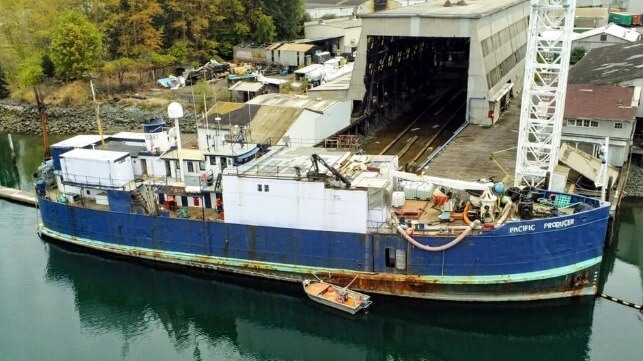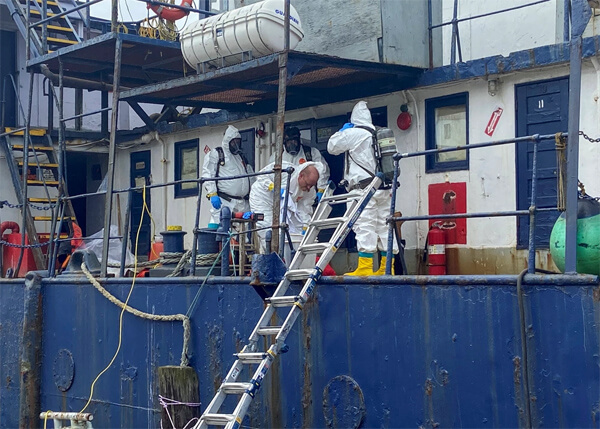Ammonia and Hazmat Remediation Completed for 77-Year-Old Derelict Vessel

The U.S. Coast Guard reports that after nearly five weeks, a derelict factory vessel used in the Alaska fishing industry has finally been remediated with the removal of hazardous materials. What is likely the last chapter in the troubled history of the 77-year-old vessel the Pacific Producer is coming to a close as local authorities and the Coast Guard are discussing proposals for the disposal of the ship, which is largely abandoned on the Tacoma, Washington waterfront.
This latest incident started on August 13 with reports of a leak in the vessel’s ammonia system. The dangerous gas is commonly used on fish processing vessels, both as refrigerant and in the processing plant. It was not the first time this vessel has reported ammonia leaks, with previous incidents in 2013 and 2018. The vessel is laid up in the Thea Foss Waterway in Tacoma however for other health and safety violations which in February 2023 led the US Coast Guard to remove its certification.
The Coast Guard, Washington Department of Ecology, and Tacoma Fire Department responded to the hazardous conditions in August and brought in a commercial remediation contractor to assist in the survey and developing a plan. The Coast Guard reported that the survey showed the concentration of ammonia was below the toxic levels but was still of concern.
The vessel was determined to present a significant threat to the environment and the Federal on Scene Coordinator took action to protect public health and the environment. The Coast Guard utilized the Comprehensive Environmental Response, Compensation, and Liability Act (Superfund), as well as the Oil Spill Liability Trust Fund, to fund response efforts.
Inspectors found several degraded ammonia tanks aboard the vessel and said that the gauges on the tanks had also been painted over. Initially, they injected CO2 into the vessel to neutralize the ammonia and were able to cut the leak rate in half before proceeding with the remediation efforts.

Hazmat teams had to be brought in to clear the vessel of hazardous materials (USCG)
“This was a complex operation that required a swift and coordinated response to ensure the protection of the public and the environment,” said Capt. Mark McDonnell, the Coast Guard Federal on Scene Coordinator. “I would like to thank our excellent partners at the Washington Department of Ecology and Department of Natural Resources, EPA, City of Tacoma, and the Puyallup Tribe for their incredible support which resulted in this successful operation.”
During the response, the USCG reports that hazmat crews removed 3,500 pounds of ammonia from the vessel. Contractors also removed miscellaneous hazmat materials from the vessel, including paint, flammable liquids, corrosives, and pressurized gas cylinders. Additionally, due to concerns about water intrusion into the vessel, 20,000 gallons of oily bilge water, 5,000 gallons of diesel fuel, as well as 14,000 gallons of miscellaneous oil and oily waste were removed and properly disposed of by the contractors.
Before this incident, the Occupational Safety and Health Administration cited the vessel for a long list of violations including two repeat serious violations, 17 serious violations, and one “other than serious” violation. The agency proposed $209,983 in penalties.
After attempting to resolve the issues with the owner of the vessel, the USCG reports that the Washington Department of Natural Resources (DNR) assumed emergency custody of the Pacific Producer. They are now saying that the DNR and Coast Guard crews from Sector Puget Sound will remain in communication over any proposed plan of action for the disposition of the vessel.
Built in 1946, and registered in the United States, the Pacific Producer was used as a seafood processing vessel. The ship is 169 feet long and 472 tons, and typically would sail to Alaska during the season, but has been out of operation since OSHA completed its most recent inspection at the end of the 2022 fishing season. Previously, in 2012, 2014, and 2018, OSHA’s inspectors also found safety violations on the vessel. The owner and the vessel had been on probation between 2017 and 2022 for the previous violations.
